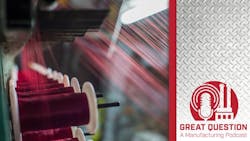The world of fabric and garment manufacturing is perpetually evolving. New advances in machinery and fiber creation are uniting fashion designs and engineers in a quest to create more sustainable and innovative textile wonders. These achievements include self-healing fabrics, 3D-printed clothing, temperature-responsive fibers, and even textiles inspired by spider silk. In this episode of Great Question: A Manufacturing Podcast, Laura Davis, the editor in chief of New Equipment Digest, explores what the future holds for the textile industry.
Below is an excerpt from the podcast:
Anouk Wipprecht is a Dutch FashionTech designer who creates designs that combine the latest in science and technology to make fashion an experience that transcends appearances. This year, she teamed up with Chromatic 3D Materials (a 3D printing manufacturer) to envision what our future wardrobe can look like when 3D printing, textiles, and electronics are combined.
Originally debuted at Formnext in November 2023—the 3D printing trade show in Germany—, the motion-activated design is one of the first garments in the world to embed electronics within the 3D-printed elastomers.
New Equipment Digest covers new products, innovations, and solutions designed for the manufacturing industry and reports on process developments, implementation strategies, key trends, and R&D breakthroughs that drive the equipment market forward.
The avant-garde design used 3D printing to attach 75 flexible, 3D-printed LED domes to the fabric of the dress without adhesives or stitching, showing not just the potential of Chromatic’s 3D-printing technology for commercial use, but the potential of the 3D-printing industry as a whole.
Wipprecht's dress demonstrates the flexibility of Chromatic’s 3D printing materials. Traditional 3D-printed materials tend to be brittle and hard, whereas Chromatic's ChromaFlow 70 offers a pliable, heat-resistant material that drapes and stretches more than four times its length without breaking or cracking. This flexibility allows a soft and seamless structural, functional, and aesthetic element that can be used for intimate and leisure apparel, sportswear, swimwear, and other apparel where silhouette and longevity are just as important as comfort.
Wipprecht says that Using Chromatic’s 3D materials to print offers numerous possibilities for the fashion industry. She explains that for designers such as herself, who use electronics in their creations, it provides a unique opportunity to embed and secure electronic parts within the printing process.
She also states that the dress is her most wearable—and washable—3D-printed dress that she's ever created as she's able to diffuse the lights since the electronics are enclosed within the material, and the flexible and strong elastomer excellently bonds to fabrics.
About the Podcast
Great Question: A Manufacturing Podcast offers news and information for the people who make, store and move things and those who manage and maintain the facilities where that work gets done. Manufacturers from chemical producers to automakers to machine shops can listen for critical insights into the technologies, economic conditions and best practices that can influence how to best run facilities to reach operational excellence.
Listen to another episode and subscribe on your favorite podcast app
About the Author
Laura Davis
Laura Davis is the editor in chief of New Equipment Digest (NED), a brand part of the Manufacturing Group at Endeavor Business Media. NED covers all products, equipment, solutions, and technology related to the broad scope of manufacturing, from mops and buckets to robots and automation. Laura has been a manufacturing product writer for six years, knowledgeable about the ins and outs of the industry along with what readers are looking for when wanting to learn about the latest products on the market.
